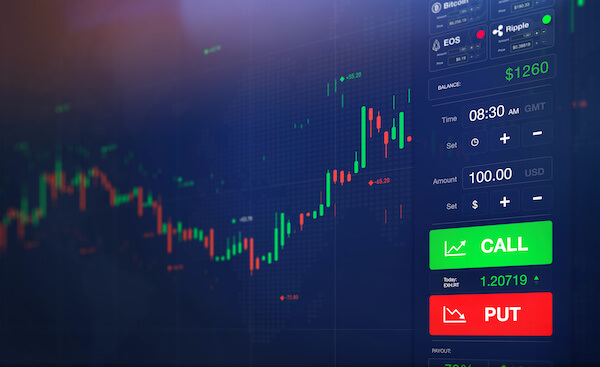
Understanding options trading and the basics of put vs call options can make all the difference for your investment portfolio.
Many investors limit themselves to buying solid, dividend-paying stocks and holding them for the long haul. But to achieve a truly diversified portfolio, the most successful investors learn about diversified investing strategies.
You’re well on your way to becoming one of those successful investors by seeking more information about how to invest. In this article, you’ll learn why investors are attracted to options trading, the difference between put options and call options, when to use each one, and how that understanding can build a solid options trading strategy.
Why Investors Are Attracted to Options Trading

Investors are attracted to stock options trading for several reasons. One of which might be the increased amount of control options trading provides.
With traditional stock market investing, investors rely on dividend income or rising share prices to make money. But with options trading, you can generate extra cash flow and protect the stocks you do own from price volatility. In fact, with some forms of options trading, you can use that volatility to your advantage.
To take advantage of options trading in order to achieve your financial goals, however, it’s important to establish a solid base of knowledge.
Establishing this solid base knowledge is the step that many investors never take. They are intimidated by the terminology — puts and calls, long calls, covered calls, iron condors, spreads, etc. But when you are educated about investing, there is no reason to be intimidated.
Aware of risk? Yes. Intimidated? No.
Put vs. Call Options: The Basics
A diversified investment portfolio will include various asset types: stocks, bonds, ETFs, mutual funds, etc. Options are just one more type of asset. Options provide certain benefits and rewards that stocks and bonds just can’t. And, of course, they also come with different kinds of risk.
Defining an Option
An option is essentially a derivatives contract that provides the buyer the right, but not the obligation, to buy or sell the underlying asset at a specific market price — known as the strike price — on or before a predetermined expiration date.
Options fall into the derivatives category because they “derive” their value from other assets, like stocks. Many options strategies you choose will be driven by current market price and your expectation for price increases or decreases in the future.
So when you purchase an option, you obtain a contract that provides you with the right to buy or sell an underlying asset at a set price at some point in the future (the “expiry” date) before that contract expires. It’s very important to remember that you’re purchasing a right, not an obligation.
Defining an Underlying Asset
An option’s underlying asset can really be anything, but in the case of a stock option, the underlying asset is a stock. You’re going to be speculating on the direction the stock market will take and ultimately what will happen to the price of the stock.
Options contracts are essentially bets on whether the underlying stock price is going to rise or fall in the future.
Cash Outlay: Options Trade vs. Stock Trade
Another important step is understanding the difference between trading options and stocks.
Unlike stocks, calls and puts are traded in contracts. Typically, one options contract is tied to 100 shares of stock. Options trade for a fraction of the price of the underlying security.
So if you buy 100 shares of XYZ stock for $50 per share, it would cost you $5,000. (This cost is also known as the premium.) But purchasing a call option or a put option, on the other hand, would cost you a fraction of that. The premium, or the price of the option, might be $4 per share, or $400 per contract. So the cash outlay is much less.
The lower cost of buying call or put options compared to buying shares of the underlying stock makes options trading very attractive.
Put vs. Call Options: The Difference
When you want to own a stock like Tesla (NASDAQ:TSLA) or Facebook (NASDAQ:FB), you buy shares. But when you trade options, you buy the right to buy or sell that stock.
Investors can tap into several types of options, but the most common types of options are put options and call options.
Put Options
With a put option, you obtain the right to sell shares of stock. Purchasing put options can act as an insurance policy for stock that you own. So if you buy a put option for XYZ Company stock with a strike price of $10, you are expecting the price movement of XYZ stock to trend downward below $10 before the option expires. You don’t want to sell the stock now, but you want to protect yourself in case the stock price falls.
An Example of a Put Option
Let’s say you saw the fall of Delta Airline (NYSE:DAL) stock coming at the first mention of COVID back in February of 2020. You realized travel restrictions were about to crush the travel industry. You were in a position to become a put buyer.
You could have purchased a put option to sell the stock at a strike price of, let’s say, $50. If the expiration was six months later, you could have then sold your shares of Delta for $50, when the price plummeted to $20 in May.
If the stock price rises, you obviously won’t exercise your put option. Just as with any insurance policy you don’t actually use, you’d simply walk away unscathed, let the options expire, and lose only the premium you paid.
Call Options
With a call option, you obtain the right to buy stock. So let’s say you decide to become the buyer of a call option for XYZ Company stock with a strike price of $10. That means you’re expecting the price of XYZ stock to rise above $10 before the option expires.
An Example of a Call Option
Let’s say you saw the exponential rise of Netflix (NASDAQ:NFLX) stock coming back in January of 2013 when the stock price was $15.
You would’ve bought a call option to purchase the stock at a strike price of, let’s say, $20. If the expiration was six months later, you could buy Netflix for $20, when the price had reached $60.
In this situation, you have a few choices:
- You could hold the stock and simply enjoy the deep discount.
- Or, you could turn around and sell the stock for a $40 per share profit. Your total profit would be $4,000 (100 shares times $40 per share).
When to Use Puts vs. Calls
So, how do you know when to use put vs. call options? It really depends on your outlook for the underlying stock and whether you feel the stock will rise (bullish) or fall (bearish).
Below is an easy table for reference.
| Outlook | Buy | Sell |
| Bullish | Calls | Puts |
| Bearish | Puts | Calls |
If you have a bullish outlook on the underlying stock, you’re expecting stock prices to increase. So, in this scenario, investors are looking to buy call options and sell put options.
When investors foresee a decrease in the market value of the underlying stock, on the other hand, they will tend to buy puts and sell call options.
Learn More About Put vs. Call Options

Are you feeling ready for options investing? Educating yourself is the first step, so well done.
If you are expecting the price of a stock to move in a certain direction and you’re in a position to tolerate the risks associated with options trading, it is possible to generate significant returns for your investment portfolio.
Maybe you have funds that need a boost and you’re feeling ready to add options to your portfolio. Don’t stop there just because you don’t know which options trades are the right ones to begin with. Subscribe to Investors Alley’s “Options Floor Trader PRO” newsletter, and we’ll show you how to find and make those trades.





